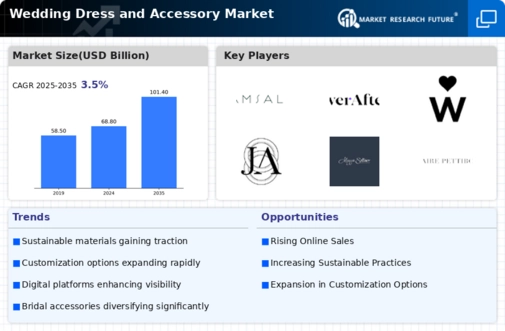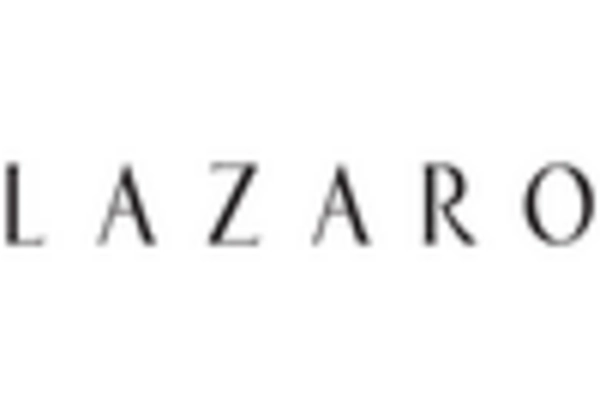Focus on Sustainability
The focus on sustainability is increasingly shaping the Wedding Dress and Accessory Market, as consumers become more environmentally conscious. There is a growing demand for eco-friendly materials and ethical production practices, prompting designers to innovate and create sustainable options. This trend is reflected in the rise of brands that specialize in sustainable wedding attire, appealing to a demographic that prioritizes environmental responsibility. Data indicates that a notable percentage of brides are willing to pay a premium for sustainable products, suggesting that this focus on sustainability could drive growth in the Wedding Dress and Accessory Market. As awareness of environmental issues continues to rise, it is likely that sustainability will remain a key driver in shaping consumer choices.
Influence of Social Media
The influence of social media on the Wedding Dress and Accessory Market cannot be overstated. Platforms such as Instagram and Pinterest serve as vital sources of inspiration for brides-to-be, showcasing the latest trends and styles. This visual medium allows designers and retailers to reach a broader audience, effectively marketing their products to potential customers. Data indicates that a significant percentage of brides utilize social media to research and select their wedding attire, which has led to an increase in online sales. As social media continues to evolve, it is likely that its impact on the Wedding Dress and Accessory Market will grow, driving innovation and encouraging brands to engage with consumers in new and creative ways.
Rising Disposable Incomes
The Wedding Dress and Accessory Market appears to be positively influenced by the increasing disposable incomes of consumers. As individuals and families experience financial growth, they are more inclined to invest in high-quality wedding attire and accessories. This trend is particularly evident in emerging markets, where economic development has led to a surge in spending on weddings. According to recent data, households with higher disposable incomes allocate a significant portion of their budget to wedding-related expenses, including dresses, veils, and jewelry. This willingness to spend suggests that the Wedding Dress and Accessory Market may continue to thrive as economic conditions improve, allowing for more extravagant celebrations and personalized choices.
Emergence of Online Retail
The emergence of online retail has transformed the Wedding Dress and Accessory Market, providing consumers with unprecedented access to a wide array of products. E-commerce platforms enable brides to explore various styles, compare prices, and read reviews from other customers, all from the comfort of their homes. This shift towards online shopping has been accelerated by advancements in technology, making it easier for consumers to purchase wedding attire without geographical limitations. Data suggests that online sales in the wedding sector have seen substantial growth, indicating a shift in consumer behavior. As more brands establish their online presence, the Wedding Dress and Accessory Market is likely to continue evolving, adapting to the preferences of tech-savvy consumers.
Cultural Influences and Traditions
Cultural influences and traditions play a pivotal role in shaping the Wedding Dress and Accessory Market. Different regions and communities have unique customs that dictate wedding attire, which can lead to diverse market demands. For instance, in some cultures, traditional garments are preferred, while others may lean towards contemporary styles. This cultural diversity creates opportunities for designers and retailers to cater to specific tastes and preferences. Furthermore, as globalization continues to connect various cultures, there is a growing interest in blending traditional and modern elements in wedding attire. This fusion may enhance the appeal of the Wedding Dress and Accessory Market, as consumers seek to express their individuality while honoring their heritage.

















Leave a Comment